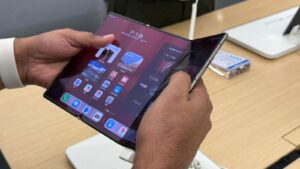Engineers once strode across Intel’s Silicon Valley headquarters with pride. The semiconductor company they worked for had helped birth the region’s tech industry, sparked the personal computer revolution and turned the tiny transistor into the brains of everything from toasters to fighter jets.
Intel did so partly by following the business philosophy of its third employee, Andy Grove, who held top leadership positions from 1979 to 2005 and was CEO from 1987 to 1998. He built the company into the dominant supplier of chips used in most computers, fostering a culture of constructive confrontation rooted in his personal motto: Only the paranoid survive.
But after Grove’s departure, Intel lost its edge. The company missed the smartphone and artificial intelligence revolutions. Its chip manufacturing prowess faltered. And on Friday, it became the recipient of one of the largest U.S. government investments in a company since the 2008 financial crisis, when President Donald Trump announced a deal for a 10% stake in the business, worth about $8.9 billion.
Intel’s journey from icon to government project makes it the latest to experience one of the tech industry’s oldest truths: Even the mightiest companies can fall from grace. Visionary founders, armed with original and disruptive ideas, often lift startups to prominence, creating businesses that can change the world. But when they leave, many of those companies miss the next wave, fall behind upstarts and slowly fade.
The tech titans of today work on the graveyards of yesterday. Apple’s headquarters sit atop what was once an enormous Hewlett-Packard site; Google works on a plot of land that Silicon Graphics once called home; and Meta took over the campus of Sun Microsystems, where it has left its predecessor’s sign as a visible reminder of the risks of complacency.
Intel avoided the downfall of others for years because its co-founders and early employees prolonged its dominance. But it couldn’t outrun the disruptive forces of Silicon Valley forever, said David Yoffie, who served on Intel’s board for nearly three decades and is a professor at Harvard Business School.
“Where they are today is something that Andy always feared,” said Yoffie, who left Intel’s board in 2018. “He feared government intervention. He feared complacency. He feared incrementalism. And all of his worst fears have been realized.”
Story continues below this ad
Intel was born in 1968 when two semiconductor pioneers — Robert Noyce, who invented the microchip; and Gordon Moore, who predicted chip performance would increase exponentially — left Fairchild Semiconductor to start a competitor. They brought with them Grove, a Hungarian-born engineer with a knack for management discipline, and spent a year developing new technologies.
The company’s first products were memory chips, slices of silicon that store short-term data. Intel later invented the chips called microprocessors that perform calculations. The U.S. government was among the earliest customers for semiconductors. Moore championed a future with chips in everything from cameras to toys to manufacturing equipment.
Hobbyists and companies in the 1970s frequently built early personal computers using Intel’s 8080 microprocessor, which outsold rival chips. The company later persuaded IBM to use Intel chips in its personal computers.
Echoing IBM, Microsoft in 1985 built its Windows software to run on Intel processors. The combination created the “Wintel era,” when the majority of the world’s computers featured Windows software and Intel hardware. Microsoft’s and Intel’s profits soared, turning them into two of the world’s most valuable companies by the mid-1990s. Most of the world’s computers soon featured “Intel Inside” stickers, making the chipmaker a household name.
Story continues below this ad
In 2009, the Obama administration was so troubled by Intel’s dominance in computer chips that it filed a broad antitrust case against the Silicon Valley giant. It was settled the next year with concessions that hardly dented the company’s profits.
By then, cracks were beginning to show. Paul Otellini, Intel’s CEO from 2005 to 2013, turned down a request from Apple to make chips for the first iPhone. He thought the price Apple offered was too low. He later expressed regret as the iPhone became a blockbuster.
“The world would have been a lot different if we’d done it,” Otellini told The Atlantic in a 2013 interview.
Intel weathered the mistake by supplying chips to the data centers that underpinned the booming cloud computing market. Its annual revenue rose to $53 billion in 2013 from $34 billion in 2005.
Story continues below this ad
Company leaders would later say that its lucrative microprocessors — which powered not only PCs but larger machines called servers — were a creosote bush, a plant that poisons competing plants around it. Intel often spun up projects for new products, only to shut them down as leaders lost patience or the technology disappointed.
One project Intel killed was a chip that could do many computations at once, emulating chips known as graphics processing units that are critical to video games and would eventually power artificial intelligence applications. But the graphics chip that Intel developed didn’t work, so it pulled the plug.
Otellini’s successor, Brian Krzanich, tried elbowing into the mobile business that Intel missed by pouring billions into creating a modem chip for iPhones. But the company struggled to develop the technology and eventually sold it to Apple, after Krzanich was forced to leave Intel over a relationship he had with an employee.
Intel also fell behind in semiconductor manufacturing as it ran into delays perfecting new production processes. That allowed rivals such as Taiwan Semiconductor Manufacturing Co. and Samsung Electronics to overtake it between 2015 and 2019.
Story continues below this ad
In 2021, Intel asked Pat Gelsinger, a former top executive, to return to lead a turnaround. Gelsinger hatched an ambitious plan to regain Intel’s manufacturing lead by introducing five new production processes in four years. He also lobbied for the Biden administration’s CHIPS Act, which designated $50 billion to revitalize U.S. chipmaking.
Gelsinger committed more than $100 billion to chip manufacturing in the United States across facilities in Arizona, Oregon, New Mexico and Ohio, where it would build a new operation.
But as Intel focused on manufacturing, the demand for graphics processing units exploded in 2022 and 2023 after an AI startup, OpenAI, used the components to train an artificial intelligence system called ChatGPT, which could write poetry, create computer code and answer complex questions. Nvidia, a rival to Intel, specialized in graphics processing units.
Intel sales sank as cloud computing companies flocked to Nvidia’s chips. At the same time, Intel’s costs from hiring and manufacturing rose.
Story continues below this ad
Last November, Intel received $7.86 billion in CHIPS Act funding from the U.S. government. It later fired Gelsinger and tapped Lip-Bu Tan, a semiconductor executive, to revive it.
Tan outlined a plan to cut staff, develop a new AI strategy and focus on finding customers for a future iteration of Intel’s chipmaking technology. But five months into the job, Trump called for Tan’s resignation, citing his investments in Chinese semiconductor companies.
The attack sent Tan to Washington this month to meet with Trump. The president proposed that Intel give the U.S. government a 10% stake in exchange for the CHIPS Act money it had been awarded. The deal was finalized Friday.
In a statement, Intel spokesperson Cory Pforzheimer said Tan “has moved quickly to shape a new Intel and advance America’s leadership in technology and manufacturing. We welcome the U.S. government’s continued investment and recognition of Intel’s critical role in achieving these national priorities.”
Story continues below this ad
In the meantime, Nvidia has become the world’s most valuable public company, worth more than $4.3 trillion. Intel, which once towered over Nvidia, is valued at $108 billion.




Average Rating